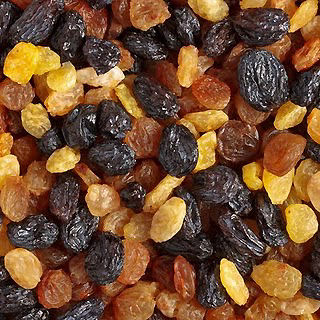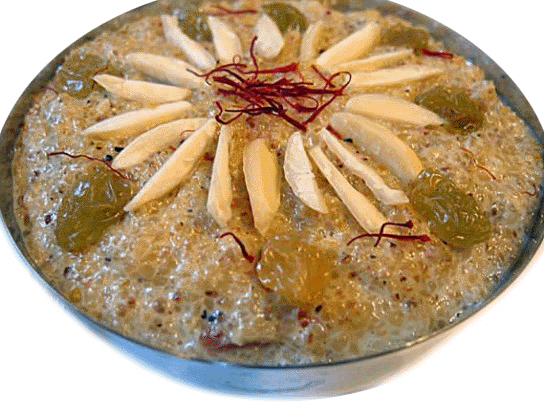
|
|
|
|
BY: SUN STAFF
 May 15, 2010 — CANADA (SUN) — A journey through India: border to border, bhoga to prasadam. Today we begin a new segment in the Prasadam series with a staple ingredient found in many vegetarian preparations: raisins. This simple foodstuff is packed with flavor and nutrition. Although it's a dried fruit, the way it plays in recipes often gives it a non-fruit role, as a sweetener, condiment or thickener. As we'll see in the recipes to follow, raisins have a tremendous range of use in cooking, from beverages to breads, salads, sabjis, rice, chutneys and sweets.
Raisins go by many names. In Sanskrit, dvipasambhava is a type of large raisin, like a date, while prthumrdvika is a grape raisin. Called kaintha thratchai in Tamil, kishmish or kismis in Hindi, ona drakshi in Kannada, the raisins or sultanas most often used are the dried grape variety. Raisins have been harvested as a foodstuff since ancient times. The earliest known grape vine is said to date back to 35,000,000 B.C. In 6,000 B.C., grapes were cultivated in Eastern Europe, and dried fruits were produced. Long ago, grapes were simply dried on the plants, then picked and stored, having a very long shelf life. Much more efficient methods are used today, of course. In India, the harvested grapes are picked, dipped in a preservative, then spread out on racks to dry in the sun. While the preservatives no doubt cut down on waste, they're not necessary to the process, and you produce your own raisins by simply picking the grapes and sun-drying them. In India, raisins have been used in temple preparations for countless years. Raisins only became popular in the West in 1873, when a grape grower lost his harvest to a severe heat wave. He took the dried fruit to a grocer in San Francisco, and they were delighted to find that customers loved them!

Although raisins are a featured ingredient in many Krsna prasadam recipes, we find relatively few references to them in sastra or Srila Prabhupada's comments. Raisins were discussed a few times during the last days of Srila Prabhupada's lila, as a foodstuff to be taken for his health. In a room conversation on October 4, 1977 in Vrindavan, Srila Prabhupada instructed the devotees to take four kismis (raisins) and an equal quantity of honey (but not too much), and make a paste of them. As we'll see in a later segment, raisins are valued in Ayurveda for their great nutritional and medicinal value. During a Srimad Bhagavatam lecture in Gorakhpur, February 10, 1971, Srila Prabhupada tells the story that as a young man, he once saw a Muhammadan who was beguiling a crowd, pretending to hand out straw or grass, but he was actually handing out raisins. When Srila Prabhupada received his raisin, he saw the hoax and immediately threw the raisin away. There is also a funny story told by Danesh dasa, that once at the 2nd Avenue in New York, the devotees served Srila Prabhupada cereal with dark raisins. He looked at them and asked, "Is it dead?" After that, the devotees only served him golden raisins, about which he never complained. Srila Prabhupada had such an excellent wit! Although we have found few other transcendental references to raisins, there is mention of them in the Govinda-lilamrita by Sri Krishna Das Kaviraj and accompanying Rasa-tarangini Tika by Sri Yadunandana Thakur, which describes Srimati Radharani's pastimes of cooking for Krishna, along with Mother Yasoda and the gopis. In part three of our segment on Camphor, we mentioned the small pies Radha made for Krsna, called Karpurakeli. There is also mention in that section of Rasa-tarangini Tika of a preparation called Chandrakanti. Mother Yasoda asked Radha's associate, Kadambari devi, to prepare for Krsna this Chandrakanti, a sesame seed cake containing raisins. Most of the recipes found today for Chandrakanti call for mung dal instead of sesame, although sesame certainly makes a more refined cake.
Ingredients:
Lightly toast the sesame seeds then grind into a fine powder. Soak the rice in water for an hour, then drain and grind to a paste. Using as little water as possible, make a batter of the sesame and rice. In a pan heat the milk and add the sugar to it, cooking until it thickens. Add the batter and raisins, stirring until the mixture becomes thick. Mix in the cardamom and remove from the heat. Next, apply a thin coating of ghee to a plate and pour the cooked mixture onto it. Let it sit for 15 minutes until the mixture hardens, then cut it into the desired shapes. (Sometimes Radharani cut the sweets for Krsna into moon shapes.) Next, fry the cut pieces in a little ghee on low heat until both sides are golden brown. Remove and offer. There are an endless number of ways to use raisins, and over the next two segments, we'll offer a selection of our favorite recipes, in many categories of prasadam preps. One of the most unique methods we'll highlight is making a paste of raisins, out of various combinations of foodstuffs. The pastes can be used as a condiment, as a stuffing, or as a coating on other baked or fried vegetables.

Doodh Dalia
| |